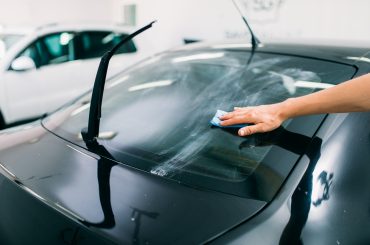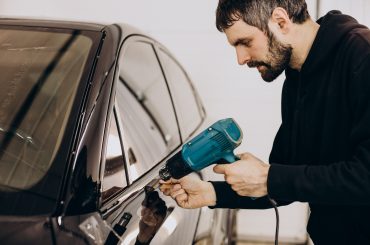Finding a proper UV blocking window film is a major interest in people who conduct researches on the topic of getting their car windows tinted. It is because ultraviolet radiation is very dangerous and would be the cause of many skin disorders. People would often be exposed to this harmful radiation while driving or traveling in vehicles. The best way to minimize this is by using a good, sun-blocking window film.
Table of Contents
Effects of UV Radiation on Humans
The skin cells are damaged by UV radiation, and it also creates wrinkles and leathering. Age spots are also created as a result of exposure to harmful radiation. It is identified that over 90% of all skin cancers occur due to UV radiation. Another major concern is the effect on the eyes. Inflammation of cornea, cataracts, and vision impairment occurs as a result.
Exposure to UV radiation also results in the weakening of the immune system. Thus, the body may be vulnerable to catch infections and more prone to diseases. UV radiation is of two main types. UVA rays have a longer wavelength when compared to UVB. Therefore, it penetrates more into the deep layers of the skin. UVB radiation is the part responsible for causing sunburns on the skin.
Does Auto Glass Block UV Radiation?
The general idea is that normal window glass does not block UV radiation completely. However, the front windshield is specially designed in modern vehicles to block most of the UVA and UVB radiation. Studies have revealed that the windshield is 94% effective in blocking UVA radiation, while the front windows only blocked 71%. Hence, people who spend most of the time driving without having a proper car window UV protection would often face the risk of skin cancer and skin damage on the side of the body exposed to sunlight.
Absorption and Reflection Mechanisms of Window Tint
There are two mechanisms used by different types of sun blocking window films to keep away the sun rays. The absorption mechanism is where the harmful radiation is absorbed by the chemical film on the window and prevents it from penetrating into the interior of the vehicle. This mechanism is most commonly used in the regular dyed window tint. But still, it is not very efficient in blocking off UV radiation. It is best known for the filtering out of visible light.
The other possible method is to reflect back the sunrays just as they strike the surface of the tint film. This is used in sun blocking window films such as metalized tint, carbon tint, and ceramic tint. It is commonly used in keeping off harmful UV and IR radiation. For more details about these, refer to our article on Types of Window Tint.
In order to compare the efficiencies of the two main types of sun-blocking window films and understand more about them, refer to the article Regular vs Ceramic Window Tint.
What is the Best UV Blocking Window Tint?
According to modern technological advancements, ceramic tint is considered the most effective UV blocking window film. It blocks over 99% of UVA and UVB radiation and thus ensures maximum safety of the passengers. This is also the most expensive type as it uses a dense ceramic film. Other types of window tints have lesser blocking abilities and are less expensive and affordable. The ability of radiation blocking depends on the Visible Light Transmission factor (VLT %). Learn more on this from the article Car Window Tinting Shades Chart.
There are new advanced varieties that have been developed to lock IR radiation as well. The main disadvantage of IR rays is that they generate heat when trapped inside a vehicle. Therefore, new products in the latest models block IR rays in proportions of 90%, 70%, 50%, and 34% depending on the qualities and prices. So, if you have a good budget, you can go for the best solution that provides optimum car window UV protection. If you are more interested in the costs of these, you are recommended to read on How Much Does it Cost to Tint Car Windows.
Some Important Health Tips
Your car window UV protection might not always be able to protect you from harmful radiation, especially as there are restrictions on the limits of darkness levels of the front windows. There are even some types of glasses that do not necessarily block harmful radiation but may reduce the amount of light penetrating inside. Learn more about this on Privacy Glass.
This exposure to harmful radiation mostly affects the drivers and front-seat passengers. Therefore, the health and safety concerns of drivers need to be improved and they are instructed to follow certain recommendations indicated below.
- Wear long-sleeved dresses when possible
- Apply good sunscreen of SPF 15 or more
- Wear sunglasses if the glare is high
- Regularly conduct self-exams on any skin infections
Advanced Technologies
The windshields are made of laminated glass with a stretchy film of plastic that is able to absorb a shock during an impact. This plastic layer helps in the process of absorbing UV radiation. Modifications have been done to improve this layer to absorb even more UV radiation and protect the passengers. UVB radiation has a short wavelength and can be blocked completely by these.
Highly optimized windshields can block up to 98% of UVA rays. This protection is similar to the Sun Protection Factor (SPF) 50 which is equivalent to the strongest sunscreens available. Considering the front seat side windows, they are made of simple tempered glass. They can only block 65% of UV rays which is equivalent to a value of SPF 16, which is a low grade of sunscreen.
New auto glasses are made with high SPF glass that is designed to cool down the car’s interior while protecting the passengers at the same time. They might be quite expensive due to the advanced technology. Refer more to the cooling mechanisms and their advancements in our article How Does Window Tint Reduce Heat Inside Our Cars?








